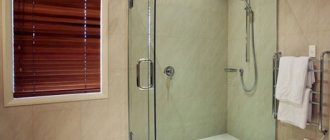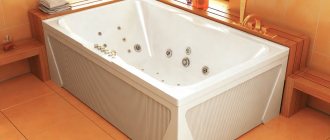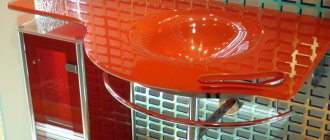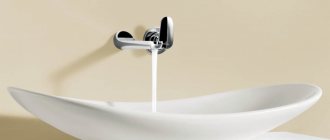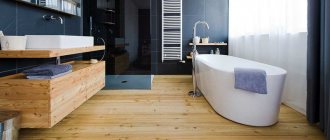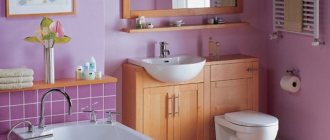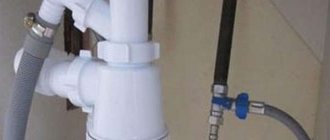The arrangement of a hygienic room hides many subtleties and nuances. We are talking not only about the purchase and installation of plumbing fixtures and fittings, but also about externally almost invisible, but important devices. One of these devices is a bathtub drain and overflow, the operating and installation features of which are worth familiarizing yourself with.
The article we have presented describes in detail the principle of operation of a drain with overflow, and examines the varieties used in everyday life. We will tell you everything about the selection criteria and the leading manufacturers in the segment. Our recommendations for care and operation will help you avoid problems and extend your service life.
Types and principle of operation of equipment
The overflow drain removes used liquid and prevents the bowl from overflowing due to uncontrolled water supply. The structure provides two holes - at the bottom and in the wall of the bathtub. They are supplied with interconnected hoses connected to the sewer drain.
Features of mechanical devices
There are three options for drain and overflow systems on sale. The difference between them lies in the method of removing the plug blocking the drain hole. If you are planning to buy a bathtub drain and overflow and are not sure which one is better to choose, you should pay attention to the model of your bathtub and its location in the room.
The simplest type of device is determined by the traditional design, found in almost every apartment. It has no moving components or levers. Water is drawn in when the plug is closed, and released when it is opened.
Mechanical products rarely break down and last a long time. The plug is attached to the drain grate on a chain, removed and placed in the opening manually
Products in this category differ in the type of connection to the sewer, sealing of connections, and the shape of the pipe. Devices include the following elements:
- Drain neck . Installed in a hole made in the bottom. It consists of a chrome funnel that “catches” large particles of debris, and an expanding pipe with a built-in nut. The parts are joined with a reinforced metal screw. A rubber ring seal is responsible for the impermeability.
- Overflow neck . Inserted into the wall of the bathtub. The design is similar to a drain, but is adjacent to the general contour of the network through a lateral, rather than direct, drainage system.
- Siphon . An arched removable pipe designed to act as a water seal. Blocks attempts of unpleasant sewer odors to enter the bathroom. Connects mechanisms with each other and with the sewer network. Available in a variety of configurations. Models with a deep shutter that holds at least 300 ml of liquid are considered optimal.
- Connecting corrugated tube . Diverts water entering the overflow to the siphon. Connects to other components with pipes.
- Auxiliary pipe - soft or hard. Provides drainage from the siphon into the sewer pipe.
The kit also includes connecting parts that increase the tightness of the system. These are flat and conical gaskets used together with a union nut. Conical products are mounted from the nut with a sharp edge so that the thin part goes inside the opposite element.
Devices not equipped with mechanisms are produced in universal sizes and are designed for bathtubs with an average distance from the center of the overflow to the drain not exceeding 57.5 centimeters
Advantages of manual strapping: budget price, simplest assembly/installation algorithm, rare breakdowns, reliability. Among the disadvantages, rapid wear of the seals should be noted.
Characteristics of semi-automatic devices
A later modification of the traditional design is a semi-automatic system. It contains the largest number of components. It is supplemented by a control unit that raises/lowers the plug, a shutter valve, and a cable that controls its position.
The control unit is implemented in the form of a handle, valve, rotary ring, button. You can operate it by turning the lever 90 degrees or pressing a button without bending over to the bottom of the bathtub. Thus, the shut-off rod rises and falls, opening or closing the valve
The system is activated by tightening and releasing an auxiliary cable located inside or outside the overflow pipe. The first option looks more aesthetically pleasing, but is much more difficult to repair.
Advantages of semi-automatic machines:
- Convenience of closing the drain (without having to bend over or wet your hands);
- comfortable management and operation;
- stylish design.
The disadvantages of the device include a complex structure with a mass of moving and connecting components and the risk of the cable jamming over time. In semi-automatic systems, the overflow holes are hidden behind the control unit. Visible details perform a decorative function in the interior thanks to a thoughtful design.
What are the benefits of automatic drains and overflows?
A distinctive feature of automatic systems is their complex structure with a click-clack valve button, equipped with a latch and a built-in spring.
In automatic systems, the button, as in mechanical ones, is operated manually (or by pressing the heel of the foot while in the shower). When pressed, the plug lowers, closing the drain opening. If you repeat the manipulation again, it rises, starting the drainage of water
The buttons are designed in elegant high-tech, modern, and retro design styles. They are made from brass and copper, coated with chrome or nickel plating.
Advantages of automated devices:
- ergonomics and presentable appearance;
- compactness;
- convenient drainage.
There are also many disadvantages: the high cost of the proposals, the vulnerability of the spring holding the valve, difficulties in replacing the button, painstaking installation, often requiring professional intervention.
The automatic drain can be equipped with the functionality of collecting water. It is considered if it is impossible to rationally place a faucet in the bathroom.
The diagram includes pipes for the liner, which are connected to the overflow hole. The bowl is filled through the top connector, which eliminates flooding, since the flow automatically stops when there is an excess of water.
In addition to the usual types of fittings, there are separate products adapted to the characteristics of specific bathtub models
What types are there?
There are not many varieties of this product based on the way it works. There are 3 types in total, which are completely different from each other:
- Mechanical systems;
- Semi-automatic;
- Automatic.
The name of each system is conditional. It reveals only the operating principle that occurs inside the equipment; automatic systems do not have any special features that allow control via a smartphone. To make it easier to navigate the store, it is important to know what the main differences between representatives are.
Mechanical option
Open overflow neck and drain hole, which is closed with a lid. Here are the main features of the equipment. The upper part can be covered with a decorative element. This does not make the throughput any worse. All functions work perfectly.
To close the bottom drain, the kit includes a special cover, which is made of plastic or metal, but has a rubberized part that ensures a tight fit. For greater convenience, some manufacturers equip the element with a chain; it allows you to quickly find the plug under water.
In many bathrooms, the mechanical product is in high demand. Because the bath itself has a long service life and is rarely changed. Of course, the product cannot provide any special features, and all actions are reduced to manual control, but its reliability has been proven over the years.
Advantages:
- Low price of equipment;
- Easy installation;
- Good durability indicator;
- Reliability.
There are disadvantages, not many of them, so most of them are conditional:
- An outdated option that is not suitable for lovers of modern solutions;
- Sometimes the plug can get lost, especially if there is a child in the apartment.
Semi-automatic devices
A modern option that features additional functionality and an affordable price. The equipment is equipped with special elements that increase operating comfort. The design of this device is much more complex, so installation work is recommended to be carried out by plumbers.
Advantages of execution:
- Convenient adjustment of the water level; a person does not need to come into contact with the water to find the plug; just turn the lever or press the button located on the overflow neck.
- Beautiful external design that stands out from the general background.
Flaws:
- If the user uses the drain hole control device several times a day, the cable will quickly become unusable and begin to work incorrectly.
- It is not recommended to install the structure in apartments where hard water flows through the water supply, because plaque will begin to form on the main elements. This will cause the equipment to break down after a couple of years of use.
Due to the fact that the system is equipped with a rotating element, this is its weak point. Therefore, the following problems occur:
- Cable breakage due to severe wear;
- Damage to the drain element;
- Flywheel failure.
There are many options for the formation of problems, so when choosing this product, attention is paid to the manufacturer and material. Everything must be manufactured at the highest level so that unexpected malfunctions do not occur. It is advisable to provide a long warranty. We also must not forget about proper operation; compliance with these rules often extends the service life by 2 times.
Automatic equipment
Of course, there is no complete automation in this product; all actions are performed using mechanical forces, as in the previous version. There are also differences, for example, to open or close, an intermediate element, for example, a cable, is not used, all actions are performed directly. This mechanism is located in the drain neck.
Advantages of the system:
- Ease of use;
- Beautiful appearance;
- There are practically no breakdowns, since there are no transmission mechanisms.
Despite the positive aspects, such equipment also has disadvantages:
- To descend from a bathtub where there is a large amount of water, you will have to dip your hand in the liquid and press the corresponding button;
- If the valve fails, a person will have to buy a new model, since the product cannot be repaired;
- Sometimes there are breakdowns of the latch where a spring is used. However, this element can be replaced, the main thing is to use the same model.
- Low bandwidth.
What are drain systems made of?
In the production of devices, materials are used that are resistant to corrosion, alkaline and acidic substances, and hot water. In the last century, when the range of plumbing equipment was quite narrow, drainage systems were made mainly of ferrous metal.
Although this material quickly loses its original aesthetics, it serves well for a long time, bravely withstanding high pressure and temperature changes. Despite its advantages, now manufacturers still give preference to non-ferrous metals and plastic.
Plastic harnesses are attractive at an affordable price. They are appropriate in bathtubs equipped with a decorative screen. Their universal dimensions adapt to non-standard sewer outlets and drains.
Plastic products are light in weight, easy to assemble, and do not undergo deformation due to the interaction of moisture and impurities contained in it
Metal objects are significantly ahead of plastic in terms of strength, service life and design. The most common products are made of brass, bronze, and copper. Chromium or nickel is applied to the drain grids and certain parts in them using electroplating techniques.
Provided that the devices are cleaned in a timely manner and the washer joints are disassembled, unlike plastic, they are unlikely to fail even after decades.
You can understand what kind of metal the structure is made of by carefully examining the pipe connecting the drain and overflow holes. Copper is recognizable by its reddish tint, ductility and softness. Brass is a durable yellow alloy of zinc and copper. Bronze is a fairly hard, dark brown material containing copper and tin.
Bronze and brass trims look great in classic and retro interiors. They look very elegant and neat, which is especially valuable when the bathtub is in the center of the room
Automatic drains and overflows
AlcaPlast A504KM
An excellent model that is distinguished by high-quality workmanship and a long service life. Drain diameter - 52 mm. The main components are made of brass and stainless steel. A special feature of the equipment is the ability to adjust the height, which greatly simplifies installation operations. The diameter of the metal plug is 70 mm. The grille is made of high-quality alloy, which shows high resistance to corrosion.
The average price is 2,850 rubles.
AlcaPlast A504KM
Advantages:
- Optimal price;
- Convenient control;
- Efficiency;
- Durability;
- Quick drain;
- Easy connection.
Flaws:
- Not found.
Timo 8004 Chrome
An automatic model, distinguished by its beautiful appearance and high price. The diameter of the hole for connecting to the sewer pipe is 4 cm. Thanks to this device, it will be easier to control the water level in the bathroom, and the original design will add attractiveness to the room. The body is made of chrome-plated brass, which shows high resistance to high temperatures and household chemicals.
The average price is 4,700 rubles.
Timo 8004 Chrome
Advantages:
- External execution;
- High service life;
- Made from wear-resistant materials;
- Universal connection sizes;
- Withstands aggressive substances;
- 5 years warranty.
Flaws:
- Not found.
Ravak X01472
An expensive option designed for users who put quality above all else. Despite the standard external design, the manufacturer approached the selection of the main elements responsibly. Therefore, the product is made of high-quality materials that retain a pleasant appearance for ten years of use.
The average price is 4,200 rubles.
Ravak X01472
Advantages:
- Convenient operation;
- Quick drain;
- The presence of a water seal;
- Metal elements are made of brass;
- Long service life.
Flaws:
- Not detected.
Main selection criteria
When choosing a device, buyers are guided by personal requirements and wishes. It is no less important to evaluate the product you like taking into account other serious criteria.
For example:
- Price category . For a low budget, plastic equipment with manual draining is optimal. A more expensive device with automatic/semi-automatic mechanisms is suitable for those who are looking for a solution with an original style and a convenient modern design.
- Material . The quality indicator of propylene is a dense shell, brass is a perfectly smooth surface, cast iron is the absence of the slightest cracks, since they cannot be repaired.
- Additional options . Siphons may have several inlets for connecting other consumers in addition to the bath. They may not be used by closing them with a nut. In the future, this thoughtful step will give you a chance to save money on branching drains under the sink, washing machine and dishwasher.
- The diameter corresponds to the siphon and sewer pipe. If the sections are incompatible, you need to select rubber or plastic adapters.
- Completeness . The kit of any system must include all elements for connection, O-rings, gaskets for pipes and overflows to prevent leaks.
Another criterion that is far from least important is the manufacturer of the plumbing fixtures. The service life and proper operation of the selected drain-overflow system depend on it.
Expert recommendations
In order to install a drain in the bathroom yourself, you do not need to have professional qualifications. If you follow the recommendations of installation technology, the quality of the work performed can be brought to the proper level.
- As a rule, each bathroom drain kit comes with instructions indicating the sequence of individual operations and a description of installation features.
- The installed device for draining water from the bathtub must be checked for tight connections. To do this, close the plug and fill the bath with water to a third of its volume. After removing the plug, all joints are checked for leaks.
If tightening the union nut does not restore the tightness of the connection, the problem can be solved by dismantling, eliminating the cause of the leak, and reassembling the device in the reverse order.
Rating of the best manufacturers
In order not to get into trouble and not suffer with a problematic product of dubious quality, you should purchase products from well-known and trusted European companies. They produce equipment according to generally accepted international standards and norms.
Geberit . A high-quality Swiss brand with a wide range of products at mid-range prices. The product is easy to use and adapts well to non-standard sizes.
Most designs have an adjustment plug near the overflow hole that opens the drain plug
Alcaplast . One of the largest manufacturers of sanitary ware in Eastern and Central Europe. The Czech brand produces devices with a special design and simple construction, which stably and silently perform their functional tasks throughout their entire service life, regardless of the influence of aggressive environmental factors.
Kaiser . Manufacturer from Germany, producing trims for modern bathtubs. The company's products allow you to adjust the length of the siphon over a wide range, which makes it possible to easily install it, including in deep bowl models.
Viega . A German company that has established itself in the market as a manufacturer of safe plumbing products of the highest quality that can last about half a century. They successfully combine design and engineering ideas.
The assortment includes drain-overflow systems with different shapes, materials, and color variations. They are characterized by a relatively low price and simple installation.
Many Viega models have a water filling function. They are convenient for rooms where there is not enough space to install a faucet.
Hansgrohe . Another representative of good German quality. The company's harnesses are reliable, efficient, and feature a complex, high-tech structure. In interiors they are valued for their functionality and excellent decorative performance.
Types of drain devices
The simplest and most well-known design today is a plug that is pulled out of the bathtub drain hole using a chain. Leading manufacturers of luxury plumbing offer various options for automating this process.
- In particular, a simple device has been developed that is attached to the overflow fitting. Water is discharged from the bathtub by turning the flag placed at the top.
- In other designs similar in purpose, the drain is controlled by turning a lever or pressing a special button.
- In modern homes, the function of automatic water supply and drainage is assigned to computer control systems such as “Smart Home”. In this embodiment, remote control is implemented via mobile communication lines.
The functionality of simple and complex devices for draining water from the bathroom includes control of the water level, eliminating overflow and flooding of residential premises.
Rules for installation work
Having experience installing a mechanical drain in a bathroom, you won’t need a circuit for a semi-automatic one - it is almost identical. Even without the skills, you can master it with your own hands, but first, it is advisable to read the instructions and documents that come with the kit.
The manufacturer's recommendations regarding the installation of the bathtub trim should be followed exactly. Otherwise, the device may not work or function incorrectly. It is not recommended to take on automatic systems: after installation without the participation of a specialist, the warranty on the device ceases to apply.
At the first stage, the old siphon, if any, is removed, and the insides of the pipe and the junction areas are thoroughly cleaned. Then the lower overflow is installed. A sealing collar is put on the outlet, after which it is placed against the drain opening.
Before installing the drain and overflow, it does not hurt to make sure that the bathtub is positioned correctly, stable and level and that the gap from the drain hole to the floor is at least 15 centimeters
Another gasket is placed on the inside of the hole, the lid with the grill is screwed on and secured with a screw. Cone-type cuffs are placed with the thick edge towards the nut, and the narrow edge towards the neck.
After checking that the connection is correct, tighten the screw with a screwdriver. The top overflow is installed using a similar method.
Tying under the bathtub is quite difficult. Most likely, you will have to take an awkward position to get to the right places. To fasten the inner and outer parts of the drain structure, it is advisable to work with a partner
The next stage is attaching the overflow to the drain. To do this, it is more convenient to use a flexible corrugated hose that stretches to a size that will easily fit into the pipe. Each joint is crimped with a nut and spacers.
Next, a glass is installed to form a water seal. Places for gaskets are first cleaned of defects with a file. The valve is also connected with a union nut with a flat or cone seal.
At the end, the siphon outlet is connected to the sewer with a drain pipe. This is done through the sealing collar or directly into the socket. To avoid leaks that occur due to cuff wear, they are treated with silicone lubricant.
When performing installation, do not use excessive physical force. Because of this, the strapping elements may burst, and you will have to buy new parts.
When the installation work is completed, you need to check the quality of the assembly by covering the drain with a stopper and opening the water. The floor under the bathroom is covered with paper, the drain and connections are inspected. When leaks are detected, the nuts are tightened.
Replacing an old siphon in the bathroom and assembling a new device
You can replace the siphon in the bathroom yourself. This will require a minimum set of tools and materials.
It is important to choose the right device that removes wastewater and prevents the spread of unpleasant odors in the room
Features of siphons.
Types and features of siphons
Based on design features, there are 3 types of bath siphons:
- Bottled. The structure includes a flask in which there is always a certain amount of water. The wastewater is discharged into the sump through a pipe of smaller diameter. When the required level is reached, the water begins to drain into the sewer. Such systems are suitable for installation in country houses. Even if the siphon is not used for a long time, it does not dry out. Several drain hoses can be connected to the flask.
- Tubular. Equipped with a flexible or stationary hose, bent in the shape of the letters S or U.
- Combined. The design includes a corrugated tube and a flask. Such systems are well suited for installation in apartment buildings.
Plastic siphons also have disadvantages:
- Short service life. Some parts fail in the first year of use.
- Insufficient tightness. When assembling systems, it is not possible to achieve a tight fit of the nuts. Therefore, the connections have to be equipped with rubber seals.
Cast iron drains are reliable and durable. Chrome elements give the siphon an aesthetic appearance. Internal surfaces are protected from dirt settling. Disadvantages include high cost and difficulty in installation. Cheaper designs are susceptible to corrosion, which reduces their service life. When replacing such a siphon, wall repairs may be required.
Required materials and tools
If you have a complete set, purchase the following materials and tools:
- screwdriver with a flat head;
- adjustable wrench;
- silicone or rubber sealant;
- sealing tape;
- basin for collecting water;
- rags.
A hacksaw may be required to change the length of the pipe. The edges are smoothed with sandpaper.
Tools for installing the siphon.
Siphon assembly
The assembly process includes the following steps:
- Formation of the flask. The bottom is screwed to the cylinder. The connection is sealed with a rubber gasket. Both ends of the drain tube are equipped with fixing nuts. This also requires installation of a seal. One end of the tube is inserted into the upper hole of the flask, the second will be connected to the neck of the siphon. The joints are coated with sealant.
- Overflow installation. The height of the hose must correspond to the location of the bathtub overflow hole. The parameter must be measured before installation work begins. If the indicators match, the overflow hose is connected to the desired outlet of the flask. The height of the collection pipe is adjustable. The part extends according to the principle of a telescope. The required length is given to the corrugated hose by stretching. A bend is formed at the desired point. The outlet and overflow pipe are connected using a nut. It is wound by hand using moderate effort.
Assembling a siphon for a bath.
Before tightening the screws, you need to make sure that the hole in the tub matches the diameter of the hose. When securing the overflow, place the gasket supplied with the siphon between the surfaces.
Installation of a new device
You can change the siphon by following these steps:
- Surface preparation. The cast iron bath near the drain hole is cleaned of contaminants and treated with a degreasing compound.
- Installation of decorative grille. If the size of the part does not correspond to the diameter of the hole, the gap is closed with sealant.
- Connecting the outlet pipe. The neck of the siphon is connected to the grille with a screw, which is tightened, ensuring a tight fit of the parts.
- Connection of the structure to the sewer pipe. The bottom of the siphon is chamfered, which allows the part to be inserted into the outlet. The elements are secured with a nut, and before screwing it on, a conical gasket is installed. The connection is treated with sealant. If the diameter of the outlet does not match the size of the sewer pipe, use a plastic adapter.
The corrugated siphon is equipped with special pipes that facilitate installation. One side is connected to the neck, the other is discharged into the sewer system. The corrugation is stretched, giving it the desired bend.
Tips for care and use
All drain and overflow systems require appropriate care. This is the only way to preserve their original condition and performance, ensure durability and high efficiency. Devices must be inspected regularly to ensure there are no mechanical damage or leaks.
Also, we must not forget about additional events:
- to prevent the accumulation of deposits and scale, the siphon is washed every three months with hot water with the addition of citric acid or suitable chemical oxidizing agents;
- approximately every six months, thin rubber gaskets that have lost their elastic properties are replaced;
- The water seal, which collects various contaminants and debris, is periodically cleaned.
If chips and cracks are detected during a visual inspection, the siphon must be replaced. Such malfunctions provoke flooding of premises and cannot be repaired.
The following article will introduce you to the intricacies of installing a conventional siphon on a bathtub, the contents of which we recommend that you familiarize yourself with.
Required materials and tools
To understand what materials you need to purchase, you need to check the siphon package. In addition to the body, a drain pipe, a decorative drain grid, and plastic and rubber cuffs are supplied. Additionally, the kit includes fasteners (bolts and nuts), sealing gaskets.
If you have a complete set, purchase the following materials and tools::
- screwdriver with a flat head;
- adjustable wrench;
- silicone or rubber sealant;
- sealing tape;
- basin for collecting water;
- rags.
A hacksaw may be required to change the length of the pipe. The edges are smoothed with sandpaper.
Tools for installing the siphon.
Installation of a semi-automatic siphon
Alkaplast bathroom overflow drain
Semi-automatic siphons (like automatic ones) can be made from:
- sanitary plastic;
- brass;
- copper;
- chrome steel;
- silumin.
Silumin siphon is the worst choice. Not only can it break during installation, but after a while it can simply fall apart. Products made of copper, brass and chrome-plated steel can be called durable, but due to their high cost they are not in great demand.
Parts and assembly order
Products made from sanitary plastic are stronger than silumin siphons and more durable, since they are not afraid of aggressive environments. A significant role in the popularity of plastic products is played by their low cost and ease of installation. As for the assembly, the process is not much more complicated than installing an ordinary plastic drain and overflow, and differs only in that instead of grilles you need to install controls, as shown in the diagram above.
What is a bathroom siphon
The drainage system designed for the bathroom is very similar to other water drainage systems. However, the design has some differences, for example, the presence of several outlets for water at once.
One of them is intended for overflow, and the second for draining. There are also special drainage systems in which filling and draining are controlled automatically or manually.
The operating principle of each such device is not complicated; when the water is drained, it does not completely go into the sewer pipes, but remains in the “elbow”, thus forming a water seal.
This helps prevent gases from entering the room. Some types of drains additionally have a mechanism that allows you to lower or raise the plug, thereby controlling the flow or filling.
Typically, a cable and a switch handle are used for control. Just turn the handle and the cable will tighten or loosen. This system allows you to draw in or flush water without putting your hands into the bathtub.
Purpose and design features
A sink drain in a bathroom or kitchen with an overflow is a curved structure, the key purpose of which is to redirect excess water into the drain, thereby preventing the sink bowl from overflowing.
The design of the bathtub drainage system is almost identical to the design intended for the sink.
Structurally, the overflow drain for a sink or sink consists of the following elements:
- siphon with water seal - is a “U”-shaped element that performs a dual task: it prevents the flow of foul odor from the sewer and protects the drain pipe located below from clogging.
- drain pipe - made of corrugated or rigid plastic pipe and designed to redirect wastewater into the sewer system.
The main secret of the functionality of the siphon is in its design. Due to the bending, the water does not completely leave the pipe. The formed water seal acts as a barrier to the penetration of sewer “ambre” into the drain hole.
Such designs are convenient because if they become clogged, they can be easily removed and cleaned mechanically or chemically.
Do you want to install a more durable device that is less prone to clogging? In this case, it is better to purchase a design in the form of an overflow drain for the sink. It differs from traditional models in that it is equipped with an additional tube.
This device connects a hole made in the upper side of the side of the bowl with the elements of the drainage system located in front of the siphon. Thanks to this, the overflow drains liquid from the sink, thereby preventing the bowl from overflowing.
From the outside, the drain hole is covered by a grill. It performs a protective function, trapping small debris and hair, thereby protecting the system from clogging.
Purpose and design of the drain
The sink drain is a curved structure, the main elements of which are a siphon and a drain pipe.
The outer element of the drain hole is a metal grill, which protects the pipe from hair and small debris.
Located just below the drain hole, the siphon performs two key functions:
- Protects the drain pipe from clogging with waste entering through the hole in the sink.
- Prevents the spread of unpleasant odors coming from the sewer pipe.
The main secret of the siphon is its bend.
Thanks to this design solution, the water does not completely leave the pipe, forming a kind of water seal, which prevents the spread of sewer “odors” in the room.
The device includes the following items:
- frame;
- exhaust pipe;
- rubber and plastic cuffs;
- decorative overlay for the hole;
- rubber stoppers;
- nuts and screws.
If the system is clogged, this siphon can be easily removed and cleaned mechanically, chemically or using the pressure of a directed jet stream. To prevent such situations, manufacturers recommend purchasing sink drains equipped with an overflow.
The design of the system differs in that it is equipped with an additional tube made of bendable corrugation or hard plastic. It connects the hole in the top side of the sink rim to the part of the drainage system that is located in front of the siphon.
This zigzag tube is fixed in the desired position using a plastic clamp.
Materials for making siphons
Today you can find similar devices on sale from various materials, but most often the structures are made of plastic. Such drains are characterized by low cost, practicality in use, and durability.
Plastic does not corrode, which extends its service life. Such models can be used for any type of bathtub; today they are even used for acrylic bowls.
But if you plan to install a bathroom made of expensive material in the room, then the siphon must match. This rule is important if the basement space will not be decorated with a screen.
In this case, the owner must choose a more expensive drain made of high-quality material. A brass or bronze siphon is popular. If the room is decorated in a modern style, then you should use a chrome model.
It is worth considering that the price for such a drain will be significantly higher than for a plastic structure.
How to clean a drain hole
There are a lot of reasons why a blockage may appear in the drain hole. It can become clogged not only with hair, but also with small debris, pellets from clothes, and the hair of four-legged pets. When all this accumulates in the drain, a lump is formed, which is the reason why the water does not drain. Moreover, this lump becomes larger and larger, and a bad smell begins to appear. Well, let's get started. To clean the drain hole, you should try the following methods:
Try clearing the blockage under the cap covering the drain hole. Even if it seems to you that the cap is clean, check it anyway. It is very likely that you will find hair there in huge quantities. Drains that have a cross plug are most susceptible to such blockages. If you have a bathroom that has a plug installed, you will need to lift the plug before cleaning. The guide plate is unscrewed, and only then can you remove the plug.
If the hair clog is deeper than you expected, then you can use:
wire hook. Take the wire hanger, untwist it and bend it into a hook. Place the hook in the drain hole and pull out the clog
Important: you need to pull out, not push, the rubbish. Otherwise, you will definitely have to call a plumber. plunger
Probably the most common method. But it will only help if the blockage is small. The plunger should be the size of the drain hole. It’s easy to clear a drain hole with a plunger, so if your drain is often clogged, it will become an indispensable assistant for you. How to make a drain hole with a plunger? Take the plug and close the drain. Lubricate the plunger with Vaseline and press it to the drain hole. Make about 10 sharp back-and-forth movements. If the water is still standing, add hot water. Fill the bathtub with enough water to cover half of the plunger. Subsequent steps are the same as described above: we try to “break through” the blockage.
cable. A cable can help with serious sewer blockages. A cable is a twisted wire with a handle at the end (it can be wooden or plastic). The advantage of this device is that it can cope with a blockage that is located at a depth of up to 9 meters. How to use the cable? Take the handle and insert the cable into the drain, hold and twist the cable with one hand, and push it deeper into the drain hole with the other. Nowadays you can find cables on the market that have interlocking hooks that help get rid of hair in the drain hole. If you feel that the cable is stuck in something, “stuck”, know that this is the place where the blockage is located. Now you need to repeat the back and forth movements several times and then you can clean the drain hole. Then you can pull out the cable.
with tape. To make a hole in the drain, you can use any adhesive tape. Cut a strip of approximately 50 cm. Place the tape in the drain hole and move it along the inner walls. Almost all the hair will remain on the tape. When you remove the tape with hair, be sure to wash away any remaining clog. chemicals. To combat blockages, you can use household chemicals. Ask the store clerk to tell you which product is better.


